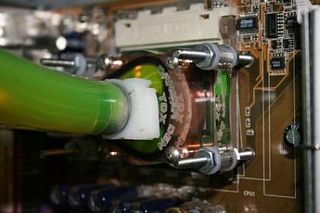DIY Water Cooling 101
Reservoir, Tubing And Coolant

There are three ways you can set up your loop to add coolant to it. The decision on how to fill your system primarily comes down to your case size and how much work you're willing to put into the maintenance of your loop.
The first method is by using a reservoir, which is simply a container with inlet and outlet hose barbs, and a screw cap that can be opened to add coolant. Using a reservoir has a few benefits, the most significant being that it is the easiest method for filling and bleeding your system. Also, placing a reservoir before the inlet of the pump guarantees a constant supply of fluid to the pump. But one thing a reservoir won't do is lower your loop's temperatures: a larger amount of water simply means it will take longer for your loop to reach its equilibrium point.
A simple, inexpensive way to fill your system is by using a T-line. This is simply a T placed in the loop, usually before the pump, that has a piece of tubing coming off of it. This acts as a small reservoir that can be filled by using a funnel. Many builders like using a T-line, not only because it is cheap, but because it takes up less space than a reservoir.
The final way to set up your system is by using a closed loop, but this requires a submersible pump. You simply place the pump in a large container of coolant and turn it on. When the loop is full, you connect the inlet of the pump to your loop. This is the most elegant design for a loop, but the most difficult to fill and bleed.
It isn't necessary to use the tubing that is sold on water cooling websites; as long as it's the right size, any tubing should work for you. Remember that tubing is measured by its inner diameter (ID) while barbs are measured by outer diameter (OD) - so if you decide to purchase the tubing and clamps at a local hardware store, make sure you get the correct size. A block with 1/2" barbs should be paired with 1/2" ID or even 3/8" ID tubing for a snug fit.
When buying from an enthusiast site, the two most common types of tubing sold are Clearflex-60 and Tygon. The main difference between the two is that Tygon is certified for lab use, and usually costs a bit more.
Also remember to buy enough clamps for each connection in your loop. There are several types of clamps - plastic, worm drive, spring - just buy the kind you find easiest to work with.
Stay on the Cutting Edge
Join the experts who read Tom's Hardware for the inside track on enthusiast PC tech news — and have for over 25 years. We'll send breaking news and in-depth reviews of CPUs, GPUs, AI, maker hardware and more straight to your inbox.
You may want to use a coolant additive in addition to distilled water to fill the loop. Again, it isn't necessary to use coolant sold at an enthusiast website; normal automotive coolant will suffice. Simply follow the directions on the bottle, and measure the correct mixture for the amount to be used in the system. There are several reasons to use an additive; the most important is to prevent a battery effect called galvanic corrosion. The additive will also help prevent any algae growth in your loop, and the added color will make it easier to spot any leaks.
Current page: Reservoir, Tubing And Coolant
Prev Page The Shroud Next Page Conclusion And General Tips-
bigdogk9 check out a company called (asetek) best water cooler systems i have ever seen or used.Reply
Most Popular

